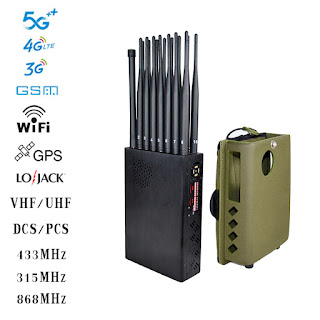Mexican drug cartels also use signal jammers to disrupt nearby cellular and radio communications
Proliferation of wireless signal jammers
Communications jamming technology is falling into the hands of paramilitary groups and criminals
Our society is increasingly dependent on wireless technology. We wake up in the morning, check email via WiFi, unlock and start the car with the keychain in our pocket, and use our cell phones to make important calls on our way to work. When we go to a new place, we rely on GPS to guide us. Stolen or misplaced items can be located via LoJack or wireless AirTags. On a larger scale, much of our military and civilian infrastructure depends on wireless communications. Unfortunately, these signals are vulnerable to another type of wireless device: signal jammers.
In general, jammers simply disrupt existing wireless signals by flooding them with noise. By adjusting the jammer to a specific target frequency range and emitting a high-power noise, tone, or pulse, the jammer can interfere with nearby receivers trying to listen for that frequency. Traditionally, this has meant interfering with radio communications, but the same core principles apply to other types of wireless signals - cellular, WiFi, Bluetooth, GPS, and so on. Jammer ranges vary depending on the power and size of the device; In urban environments, small handheld jammers may be effective at a range of 100 meters or less, while large military-grade jammers can be installed in locations that easily cover hundreds of miles of open terrain.
Military and paramilitary uses of signal jammers
Jammers were widely used during World War II, when the Nazis jammed Allied radio transmissions in occupied Europe, and only became increasingly popular during the Cold War. The Soviet Union and China jammed incoming signals, Cuba blocked American radio stations, and North and South Korea jammed each other's transmissions. Signal jammers are still widely used as a component of electronic warfare (EW), especially by the Russian military. Russia reportedly used the technology to interfere with U.S. low-altitude surveillance drones during the Syrian conflict in 2018; It is unclear whether this caused them to crash or simply go off course. There have also been reports that Russia has used powerful gps blocker on its eastern border, causing Latvia's phone system to go down and planes in the area to lose GPS signals.
Without further ado, jammers have become a very popular tool among Mexican drug cartels. They appear to go hand in hand with another technology adopted by the cartels: drones.
Small commercial drones have been used to monitor territory, especially at night with the help of thermal cameras. They are also weaponized and can drop explosives on targets, a tactic previously used by the Islamic State and other terrorist groups in the Middle East. As a result, cartel members wear portable signal jammers that can interfere with nearby drone uplinks as well as cellular and radio communications.
Civil black market and criminal use
At this point, you might be thinking, "I'm not a high-value military target or part of a warring drug cartel, so I don't have any reason to care about gsm signal jammer." However, this is not the case. Signal jammers are cheap, easy to use, and available online at any time to people who know where to find them. They can affect your daily life in a number of ways - veteran surveillance device maker Tiny Transmitters has posted some surprising demonstrations on Instagram to prove it.
The first demonstration video clip shows how a portable jammer can be tuned to the frequency of a car keychain and block its signal when the switch is pressed. This means a thief can see you park, turn on the jammer before you press the lock button on your remote key, and prevent your car from locking. Unless you happen to notice that your vehicle isn't rattling or flashing, you might assume it's locked and walk away, allowing criminals to steal any valuables inside (or take the car itself).
Another video shows how a jammer can be used to interrupt a wireless doorbell camera by blocking its ability to communicate with a home WiFi network. Unless the camera has a hard-wired data connection (unlike most Ring, Blink, Wyze, and Nest doorbell cameras), it won't be able to stream video to a cloud server or alert the homeowner that someone is at the door. Tiny Transmitters explains: "As you can guess, running an all-wireless home security system has a fundamental and terrible flaw: the wireless signal can be interfered with."
Wireless signal jammers have many other possible applications, from secretly intercepting cell phone calls to disabling GPS tracking devices. These uses are illegal, but as we know, motivated criminals are unlikely to be able to reconsider the law and FCC regulations.
We're not trying to tell you to stop using WiFi, throw away your phone, or throw away your ham radio - wireless devices are convenient and very useful in an emergency. However, for the safety of your family and property, it is wise to keep in mind its potential vulnerabilities and take steps to limit over-reliance on wireless devices.




Comments
Post a Comment